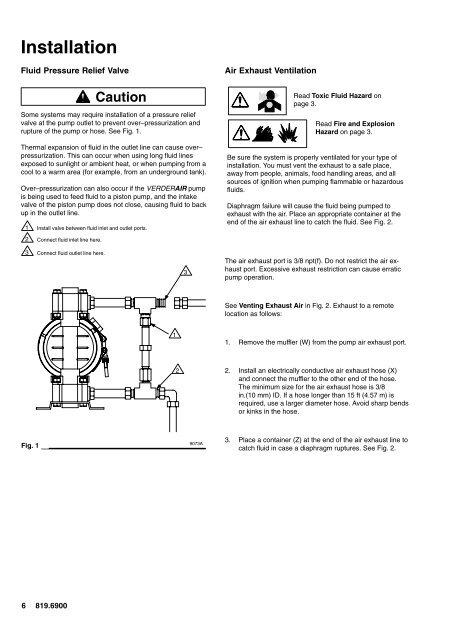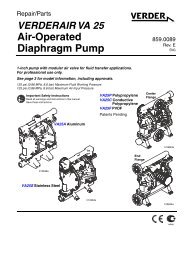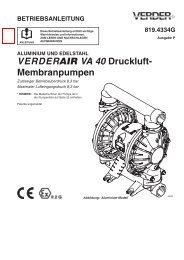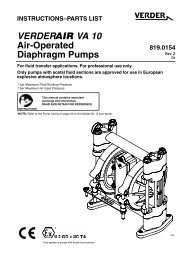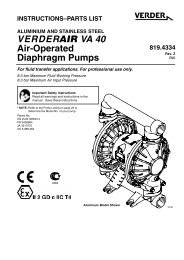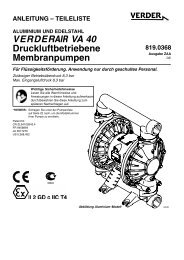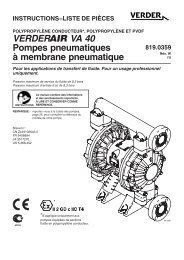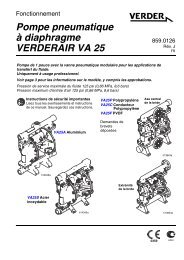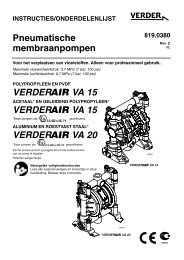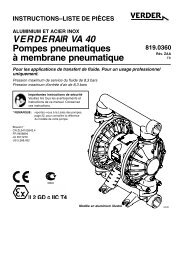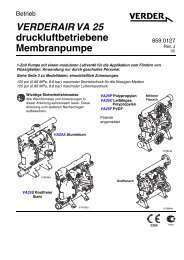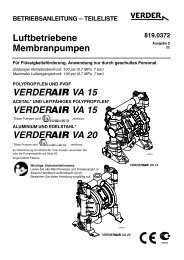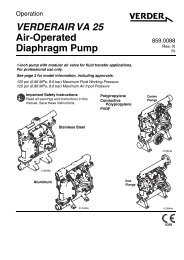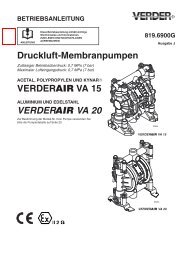Air-Operated Diaphragm Pumps VERDER VA 15 VERDER VA 15 VERDER VA 20
verderair va 20 - Double Diaphragm Pump
verderair va 20 - Double Diaphragm Pump
You also want an ePaper? Increase the reach of your titles
YUMPU automatically turns print PDFs into web optimized ePapers that Google loves.
Installation<br />
Fluid Pressure Relief Valve<br />
Caution<br />
Some systems may require installation of a pressure relief<br />
valve at the pump outlet to prevent over–pressurization and<br />
rupture of the pump or hose. See Fig. 1.<br />
Thermal expansion of fluid in the outlet line can cause over–<br />
pressurization. This can occur when using long fluid lines<br />
exposed to sunlight or ambient heat, or when pumping from a<br />
cool to a warm area (for example, from an underground tank).<br />
Over–pressurization can also occur if the <strong>VERDER</strong>AIR pump<br />
is being used to feed fluid to a piston pump, and the intake<br />
valve of the piston pump does not close, causing fluid to back<br />
up in the outlet line.<br />
1<br />
Install valve between fluid inlet and outlet ports.<br />
<strong>Air</strong> Exhaust Ventilation<br />
Read Toxic Fluid Hazard on<br />
page 3.<br />
Read Fire and Explosion<br />
Hazard on page 3.<br />
Be sure the system is properly ventilated for your type of<br />
installation. You must vent the exhaust to a safe place,<br />
away from people, animals, food handling areas, and all<br />
sources of ignition when pumping flammable or hazardous<br />
fluids.<br />
<strong>Diaphragm</strong> failure will cause the fluid being pumped to<br />
exhaust with the air. Place an appropriate container at the<br />
end of the air exhaust line to catch the fluid. See Fig. 2.<br />
2 Connect fluid inlet line here.<br />
3<br />
Connect fluid outlet line here.<br />
3<br />
The air exhaust port is 3/8 npt(f). Do not restrict the air exhaust<br />
port. Excessive exhaust restriction can cause erratic<br />
pump operation.<br />
See Venting Exhaust <strong>Air</strong> in Fig. 2. Exhaust to a remote<br />
location as follows:<br />
1<br />
1. Remove the muffler (W) from the pump air exhaust port.<br />
2<br />
2. Install an electrically conductive air exhaust hose (X)<br />
and connect the muffler to the other end of the hose.<br />
The minimum size for the air exhaust hose is 3/8<br />
in.(10 mm) ID. If a hose longer than <strong>15</strong> ft (4.57 m) is<br />
required, use a larger diameter hose. Avoid sharp bends<br />
or kinks in the hose.<br />
Fig. 1<br />
9073A<br />
3. Place a container (Z) at the end of the air exhaust line to<br />
catch fluid in case a diaphragm ruptures. See Fig. 2.<br />
6 819.6900


